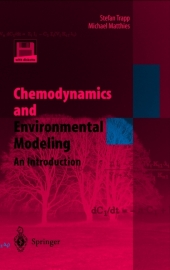 Neuerscheinungen 2011Stand: 2020-01-07 |
Schnellsuche
ISBN/Stichwort/Autor
|
Herderstraße 10
10625 Berlin
Tel.: 030 315 714 16
Fax 030 315 714 14
info@buchspektrum.de |

Michael Matthies, Stefan Trapp
(Beteiligte)
Chemodynamics and Environmental Modeling
An Introduction
Softcover reprint of the original 1st ed. 1998. 2011. xvi, 285 S. 12 Tabellen. 235 mm
Verlag/Jahr: SPRINGER, BERLIN 2011
ISBN: 3-642-80431-4 (3642804314)
Neue ISBN: 978-3-642-80431-1 (9783642804311)
Preis und Lieferzeit: Bitte klicken
Partitioning of chemicals in the environment and its modeling is becoming an important field in environmental science and engineering. This book enables students, researchers, and interested laymen to enter the field of environmental modeling in a fast and effective way. The book contains modeling software (CemoS V 1.10), data sets and the CemoS handbook. Each chapter contains examples and exercises. The book is for those interested in modeling exposure to chemicals. It contains two parts: part one is the text book which allows the reader to learn about the dynamic behavior of chemicals in our environment. Basics of exposure estimation, mathematics and chemistry are explained in the first chapters, followed by a guide to exposure models for all environmental media. Part two is the software tool "Cemos" (Chemical exposure model System) which includes nine exposure models, a substance database with twelve data sets, data estimation routines, quality assurance tools and a hypertext online help. The disk is quickly installed and runs on DOS 3.3 or higher (up to WINDOWS NT). The comprehensive Cemos manual is also included. It is identical to the online help. All equations used in the program are described in detail, making the calculations fully transparent. Exercises with solutions, example calculations and a database help the reader to learn about and apply exposure models.
1: Textbook.- 1 Why Model Chemical Exposure?.- 1.1 Introduction.- 1.2 Good Modeling Practice.- 2 Compartment Systems.- 2.1 Compartments.- 2.2 Mass Balance / Linear Differential Equations.- 2.3 Differential Equation Systems.- 2.4 Numerical Solution Methods for Ordinary Differential Equations.- 3 Transport and Transformation Processes.- 3.1 Diffusion.- 3.2 Dispersion.- 3.3 Advection (Convection).- 3.4 Combination of Diffusion, Dispersion and Advection.- 3.5 Reaction, Metabolism and Elimination.- 3.6 Combination of Dispersion, Advection and Elimination.- 3.7 Numerical Solution of the Dispersion-Advection Equation.- 4 Partitioning of Chemicals in the Environment.- 4.1 Division into Phases.- 4.2 The Partition Coefficient.- 4.3 Partition Coefficients for Dissociating Chemicals.- 4.4 Combination of Partition Coefficients.- 4.5 About Equilibrium.- 5 Multi-Media Models.- 5.1 Introduction.- 5.2 Partition Models for Multi-Compartment Systems.- 5.3 ´Mackay Models´.- 5.4 What Do These Models Tell Us?.- 5.5 Regional Exposure Model.- 6 Contaminants in Surface Water.- 6.1 Introduction.- 6.2 Analytical Steady-State Surface Water Model WATER.- 6.3 Dynamic Numerical TOXRIV Model.- 6.4 Two-Dimensional Approach.- 6.5 How to Obtain Hydrological Data.- 6.6 Contaminants in Waste Water Treatment Plants.- 7 Transport and Transformation of Compounds in Soil.- 7.1 Soil and Its Functions.- 7.2 Transport Processes of Substances in Soil.- 7.3 SOIL - Analytical Solutions for Vertical Transport in Soil.- 7.4 Comment.- 7.5 Discrete Cascade Model BUCKETS.- 8 Atmospheric Transport Models.- 8.1 Introduction.- 8.2 Model Approaches AIR and PLUME.- 9 Uptake by Plants.- 9.1 Significance of the Problem.- 9.2 Anatomical and Physiological Principles of Plants.- 9.3 PLANT Model.- 9.4 Limitations.- 10 Model for Food Chains.- 10.1 Problem Definition.- 10.2 Mathematical Formulation of the CHAIN Model.- 11 Data Estimation.- 11.1 Some Words on Data Quality and Data Estimation.- 11.2 Calculation of Molar Mass.- 11.3 Partition Coefficient n-Octanol to Water Kow.- 11.4 Partition Coefficient Organic Carbon to Water Koc.- 11.5 Partition Coefficient Between Air and Water KAW.- 11.6 Estimation of Bioconcentration Factors for Biota.- 11.7 Molecular Diffusion Coefficients.- 11.8 Substance Database.- Solutions of the Exercises.- References.- 2: CemoS User´s Manual.


